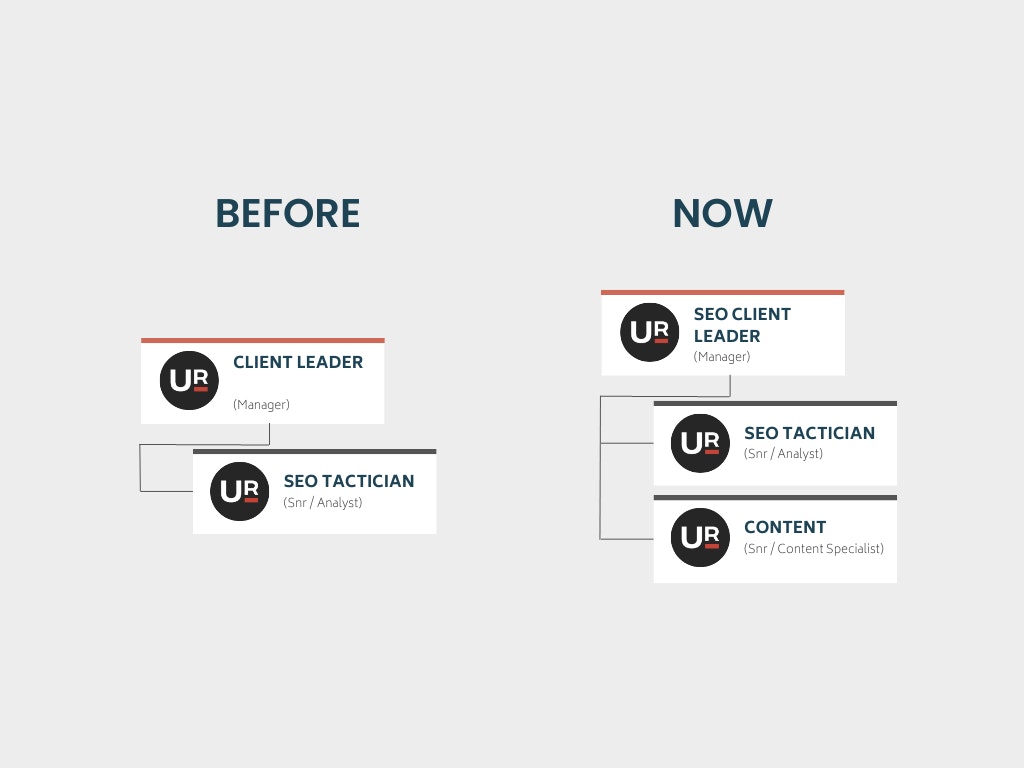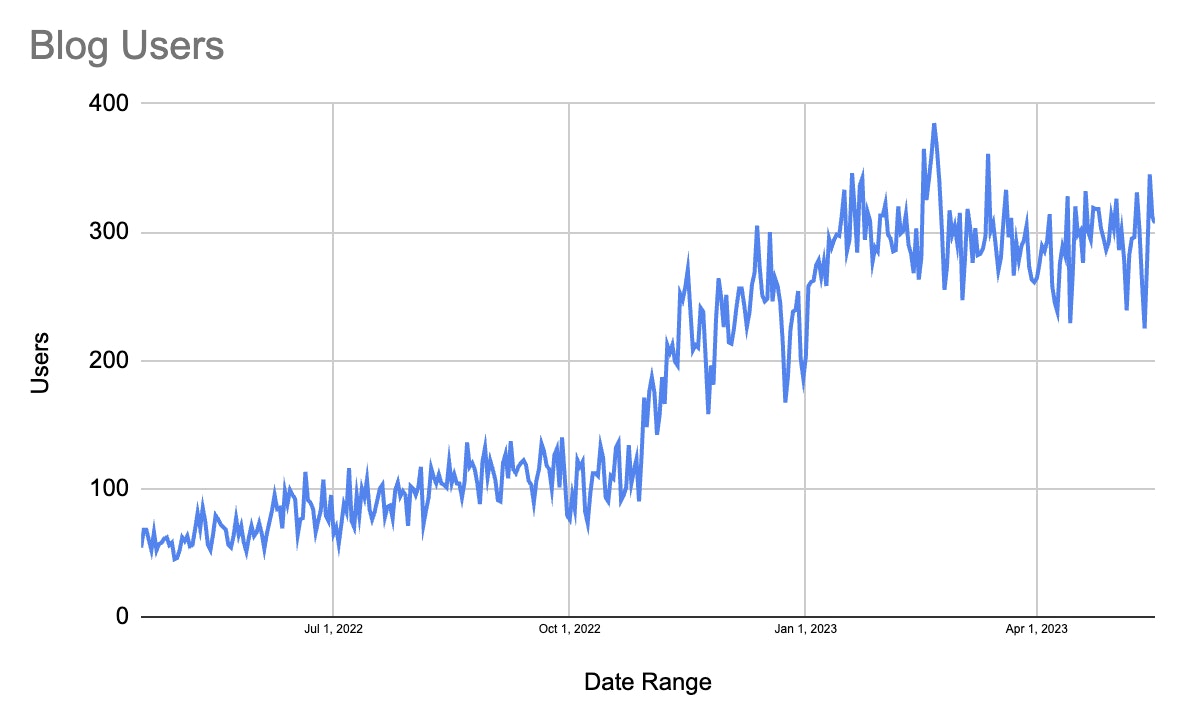Table of Contents
Content is an essential part of digital growth, but what happens when you don't have the resources to execute at scale?
It was a humbling question we had to face head-on. As we started to pitch (and land!) bigger client engagements, we found ourselves hitting a content ceiling.
It didn't come from a lack of experience or knowledge. We pride ourselves on pioneering new content tactics and staying up-to-date with the latest trends. Instead, it came from an engagement structure that prevented us from scaling content strategies with ease.
There were some road bumps we had to identify before coming up with a plan. But what was the first step to solving the issue and propelling our agency forward?
Introducing, drumroll please, the Uproer Content Specialist.
In this article, we'll dive into what Uproer looked like before content specialists and how creating this role and team opened up a new set of shiny doors for our search marketing agency.
The Role of Content at Uproer
Content is the backbone for the majority of our holistic search engagements. It creates a strong bridge between SEO and SEM, allowing us to seamlessly combine our initiatives (see SEO vs. SEM vs. Content: Demystifying the Beef).
When we say content, we're talking about:
- Blog articles
- Landing pages
- Ad copy
- On-page optimization... and beyond!
Creating Conversion-Driving Content
In holistic engagements, we prioritize content creation based not only on what performs well organically but also on what will best support paid search. For many engagements, we create bottom-funnel pages first, so that the SEM team can immediately start using them in their ad strategy. Then, we work our way up the funnel to meet organic users at all stages of their shopping journey.
Optimizing Existing Content
Content doesn't always involve new content creation. In any engagement, whether it's holistic or just SEO/SEM, we want to make sure our client's landing pages are optimized for search, conversions, and humans. Whether it's consistent content refreshing or executing on-page updates, we make sure landing pages are set up for success across each channel.
Developing 'Repurposable' Content
It's important to note that our content strategies do not stop at search marketing. While our focus is on search, our end goal is to create valuable assets that can be repurposed across our clients' marketing channels.
Because of this, we keep tabs on our clients' other marketing initiatives. We hit subscribe on their newsletters, and we follow them on socials. We strive to build value around our content that goes beyond organic and paid conversions.
Life Before Hiring Content Specialists
Like any quickly growing agency, we started to feel some growing pains, especially around our content offering. We eventually used the pain points we were experiencing to help write a new job description for the Uproer content specialist. Here's what we learned.
Analyst Burnout on Content
One question we started asking our analysts was, "If there is one thing that could be taken off your plate, what would it be?"
The answers were always content-related.
We found that analysts were spending a good portion of their weeks managing content workflows, outlining content, and communicating with copywriters.
The analyst role, especially at the entry-level position, was turning into a content production role by default. This left less time for analysts to develop other relevant skills, like technical SEO, strategy building, and drawing insights from reporting.
Lack of Content Consistency Across Clients
With no content team, there was a lack of consistency across clients. Each analyst had their own way of approaching the content workflow and approval process. For new hires, the expectations for what a typical engagement should look like started to blur.
Our copywriting manifesto was the starting point for creating this process, but we soon realized that we needed a team to manage it.
We Hit a Ceiling for Scaling Content
As we grew our expertise and experience in search marketing content, we began hearing more things from clients, like, "What would happen if we tripled our production next month?"
Exciting stuff, right? In part, it's always great when clients express eagerness to double or triple the work we do as a result of the success we're driving for their company.
But we found that we started to hit a production ceiling as analysts continued to manage everything content-related.
It was apparent that we didn't have the full capacity to take on the amount of content work that we knew we were capable of offering. We needed to build a content team solely dedicated to improving the content production lifecycle, giving more time back to our analysts to focus on strategy.
What Happened When We Hired a Content Team
We went through a rigorous process of searching for the right fit for our content team. Our criteria were simple: someone who was organized to a tee and liked reading. We ended up hiring two firecrackers, and we found that it not only improved our content output but also our team's internal capacity.
Client Engagement Structure Improved
When our specialists were onboarded, we were able to step back and review how we were staffing our client teams. Almost every SEO client was using some part of our content offering as it stood, which made it a no-brainer to staff content specialists.

Now all client engagements have expanded capacity with an additional content powerhouse.
Time & Brain Power Was Given Back to Analysts
By adding content specialists to manage and engage with the content process, we were able to give our analysts and tacticians their time back to lean into more strategic thinking.
Analysts have been able to substantially level up their analytics game (just in time for GA4!) and dive head-first into building and executing strategic initiatives.
We Created a More Granular Content Lifecycle
We were able to think more deeply about our content and the lifecycle it takes through to production. The document we created helps explain the content creation lifecycle, from initial onboarding to content deliverables.
It's a guideline, not a mandate, and it helps clarify and operationalize our content work. Here's what's different:
- Built-in pre-wiring specific to content
- Client stakeholder meetings devoted to content
- Clear content production workflows
- Clear content communication routes internally and externally
- A new lens on content ideation
- We know who is doing what and when
- The content updating process is defined and scalable
All of this leads to higher quality and better-performing content.
We Scaled Content Production for Clients
And all of that organization and management is for naught if we don't see client results. Across our suite of clients, we're able to scale from 4 pieces a month (an average) to up to 12 per month per client.
For one client in the B2B E-commerce apparel space, after tripling our content output, we saw these organic results (6mo/6mo) P/P:
| Users | Transactions | Revenue | |
| Blog | +204.59% | +600.00% | +725.75% (+$4,600.63) |

Without content specialists, we would not have been able to scale this client's content work, which would have significantly impacted revenue and users.
Into the Future...What Does Content Look Like at Uproer?
And this is just the start. Our content specialists have opened a new set of possibilities for content generation and management, which means that we have so much to tackle in the coming years.
Thinking Beyond the Blog
We're looking to continue to improve our content offering beyond just words on the page. We see the social trends and how people interact with video, infographics, and other visual content, and this makes us excited to try some of it ourselves.
We want to ask ourselves, "If this content isn't a blog post, what else can it be? And how do we scale that type of content creation in a way that speaks to our growth marketing mindset?"
Holistic Search & Content
We see content as the zipper between SEO and SEM. We know that good content will convert, so why not expand that into the SEM work we do?
We wrote a whole piece on this concept and how content, SEO, and SEM work together on content generation, advertising, and optimization to build powerful strategies that convert. We are still working on how that scales for our clients and are so excited about the future of this initiative.
Agency Recognition for Marketing and Content
And lastly, we want to be recognized for our work in content and marketing. Uproer is currently a search agency that does content. We believe that those things should be one and the same.
Over the next few years, you'll hear more about how we operate with content, why it's an integral part of SEO and SEM, and how it plays a role in both the e-commerce and SaaS spaces.
All This to Say, We're Getting Really Into Content
Content isn't new. And the power of content in digital marketing isn't a new concept either. With content, you can scale results from holistic search marketing strategies and build businesses that thrive in any digital weather. If you need support in that - you can call on us to help. Reach out to our team today by sending us a quick message.

